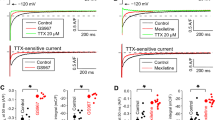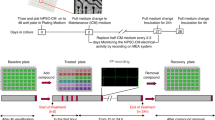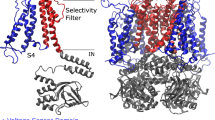Abstract
Aim:
To investigate the effects of hydroxyzine on human ether-a-go-go-related gene (hERG) channels to determine the electrolphysiological basis for its proarrhythmic effects.
Methods:
hERG channels were expressed in Xenopus oocytes and HEK293 cells, and the effects of hydroxyzine on the channels were examined using two-microelectrode voltage-clamp and patch-clamp techniques, respectively. The effects of hydroxyzine on action potential duration were examined in guinea pig ventricular myocytes using current clamp.
Results:
Hydroxyzine (0.2 and 2 μmol/L) significantly increased the action potential duration at 90% repolarization (APD90) in both concentration- and time-dependent manners. Hydroxyzine (0.03–3 μmol/L) blocked both the steady-state and tail hERG currents. The block was voltage-dependent, and the values of IC50 for blocking the steady-state and tail currents at +20 mV was 0.18±0.02 μmol/L and 0.16±0.01 μmol/L, respectively, in HEK293 cells. Hydroxyzine (5 μmol/L) affected both the activated and the inactivated states of the channels, but not the closed state. The S6 domain mutation Y652A attenuated the blocking of hERG current by ∼6-fold.
Conclusion:
The results suggest that hydroxyzine could block hERG channels and prolong APD. The tyrosine at position 652 in the channel may be responsible for the proarrhythmic effects of hydroxyzine.
Similar content being viewed by others
Log in or create a free account to read this content
Gain free access to this article, as well as selected content from this journal and more on nature.com
or
References
Grunnet M . Repolarization of the cardiac action potential. Does an increase in repolarization capacity constitute a new anti-arrhythmic principle? Acta Physiol (Oxf) 2010; 198 (Suppl 676): 1–48.
Tamargo J, Caballero R, Gomez R, Valenzuela C, Delpon E . Pharmacology of cardiac potassium channels. Cardiovasc Res 2004; 62: 9–33.
Jo SH, Hong HK, Chong SH, Choe H . Protriptyline block of the human ether-a-go-go-related gene (HERG) K+ channel. Life Sci 2008; 82: 331–40.
Hong HK, Jo SH . Block of HERG K channel by classic histamine h(1) receptor antagonist chlorpheniramine. Korean J Physiol Pharmacol 2009; 13: 215–20.
Dennis A, Wang L, Wan X, Ficker E . hERG channel trafficking: novel targets in drug-induced long QT syndrome. Biochem Soc Trans 2007; 35: 1060–3.
Rajamani S, Eckhardt LL, Valdivia CR, Klemens CA, Gillman BM, Anderson CL, et al. Drug-induced long QT syndrome: hERG K+ channel block and disruption of protein trafficking by fluoxetine and norfluoxetine. Br J Pharmacol 2006; 149: 481–9.
Wong AR, Rasool AH . Hydroxyzine-induced supraventricular tachycardia in a nine-year-old child. Singapore Med J 2004; 45: 90–2.
Wang WX, Ebert SN, Liu XK, Chen YW, Drici MD, Woosley RL . “Conventional” antihistamines slow cardiac repolarization in isolated perfused (Langendorff) feline hearts. J Cardiovasc Pharmacol 1998; 32: 123–8.
Taglialatela M, Timmerman H, Annunziato L . Cardiotoxic potential and CNS effects of first-generation antihistamines. Trends Pharmacol Sci 2000; 21: 52–6.
Magera BE, Betlach CJ, Sweatt AP, Derrick CW Jr . Hydroxyzine intoxication in a 13-month-old child. Pediatrics 1981; 67: 280–3.
Suessbrich H, Waldegger S, Lang F, Busch AE . Blockade of HERG channels expressed in Xenopus oocytes by the histamine receptor antagonists terfenadine and astemizole. FEBS Lett 1996; 385: 77–80.
Choi SY, Koh YS, Jo SH . Inhibition of human ether-a-go-go-related gene K+ channel and IKr of guinea pig cardiomyocytes by antipsychotic drug trifluoperazine. J Pharmacol Exp Ther 2005; 313: 888–95.
Zhou Z, Gong Q, Ye B, Fan Z, Makielski JC, Robertson GA, et al. Properties of HERG channels stably expressed in HEK 293 cells studied at physiological temperature. Biophys J 1998; 74: 230–41.
Hamill OP, Marty A, Neher E, Sakmann B, Sigworth FJ . Improved patch-clamp techniques for high-resolution current recording from cells and cell-free membrane patches. Pflugers Arch 1981; 391: 85–100.
Zhou Y, MacKinnon R . The occupancy of ions in the K+ selectivity filter: charge balance and coupling of ion binding to a protein conformational change underlie high conduction rates. J Mol Biol 2003; 333: 965–75.
Sali A, Blundell TL . Comparative protein modelling by satisfaction of spatial restraints. J Mol Biol 1993; 234: 779–815.
Friesner RA, Banks JL, Murphy RB, Halgren TA, Klicic JJ, Mainz DT, et al. Glide: a new approach for rapid, accurate docking and scoring. 1. Method and assessment of docking accuracy. J Med Chem 2004; 47: 1739–49.
Friesner RA, Murphy RB, Repasky MP, Frye LL, Greenwood JR, Halgren TA, et al. Extra precision glide: docking and scoring incorporating a model of hydrophobic enclosure for protein-ligand complexes. J Med Chem 2006; 49: 6177–96.
Sanchez-Chapula JA, Navarro-Polanco RA, Culberson C, Chen J, Sanguinetti MC . Molecular determinants of voltage-dependent human ether-a-go-go related gene (hERG) K+ channel block. J Biol Chem 2002; 277: 23587–95.
Mitcheson JS, Chen J, Lin M, Culberson C, Sanguinetti MC . A structural basis for drug-induced long QT syndrome. Proc Natl Acad Sci U S A 2000; 97: 12329–33.
Witchel HJ, Hancox JC . Familial and acquired long QT syndrome and the cardiac rapid delayed rectifier potassium current. Clin Exp Pharmacol Physiol 2000; 27: 753–66.
Taglialatela M, Castaldo P, Pannaccione A, Giorgio G, Annunziato L . Human ether-a-go-go-related gene (HERG) K+ channels as pharma-cological targets: present and future implications. Biochem Pharmacol 1998; 55: 1741–6.
Yap YG, Camm AJ . Potential cardiac toxicity of H1-antihistamines. Clin Allergy Immunol 2002; 17: 389–419.
Roden DM . Drug-induced prolongation of the QT interval. N Engl J Med 2004; 350: 1013–22.
Simons FE, Simons KJ, Frith EM . The pharmacokinetics and antihistaminic of the H1 receptor antagonist hydroxyzine. J Allergy Clin Immunol 1984; 73: 69–75.
Sanguinetti MC, Jiang C, Curran ME, Keating MT . A mechanistic link between an inherited and an acquired cardiac arrhythmia: hERG encodes the Ikr potassium channel. Cell 1996; 81: 299–307.
Keating MT, Sanguinetti MC . Molecular and cellular mechanisms of cardiac arrhythmias. Cell 2001; 104: 569–80.
Sakaguchi T, Itoh H, Ding WG, Tsuji K, Nagaoka I, Oka Y, et al. Hydroxyzine, a first generation H(1)-receptor antagonist, inhibits human ether-a-go-go-related gene (HERG) current and causes syncope in a patient with the HERG mutation. J Pharmacol Sci 2008; 108: 462–71.
Choe H, Nah KH, Lee SN, Lee HS, Jo SH, Leem CH, et al. A novel hypothesis for the binding mode of HERG channel blockers. Biochem Biophys Res Commun 2006; 344: 72–8.
Acknowledgements
This study was supported by a grant (08172KFDA465) from the Korea Food & Drug Administration and a grant (A100096) of the Korea Healthcare technology R&D Project, Ministry for Health, Welfare & Family Affairs, Republic of Korea.
Author information
Authors and Affiliations
Corresponding authors
Rights and permissions
About this article
Cite this article
Lee, B., Lee, S., Chu, D. et al. Effects of the histamine H1 receptor antagonist hydroxyzine on hERG K+ channels and cardiac action potential duration. Acta Pharmacol Sin 32, 1128–1137 (2011). https://doi.org/10.1038/aps.2011.66
Received:
Accepted:
Published:
Issue date:
DOI: https://doi.org/10.1038/aps.2011.66
Keywords
This article is cited by
-
QT prolongation induced by hydroxyzine: a pharmacovigilance case report
European Journal of Clinical Pharmacology (2015)



